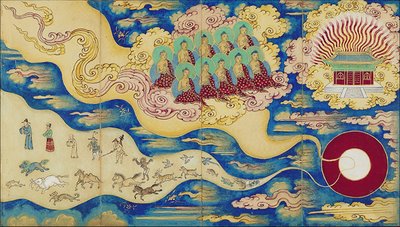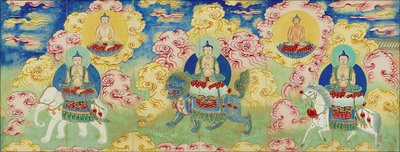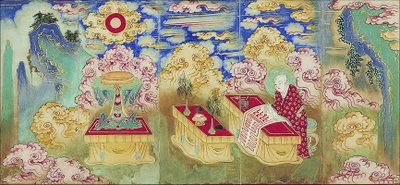








'The Six Perfections'
"Derived from the Sanskrit Pāramitā, the six perfections literally means crossing over to the other shore. In Buddhism it symbolizes transition of the sentient beings from suffering shore to the other shore of spiritual liberation.The images here are taken from a single text among the Six Perfections - The Vajra-Wisdom Tantra of Deep Meditation:
The Six Perfections includes six Buddhist scriptures related to Tibeto-Chinese art dated 14th and 15th centuries collected at the National Palace Museum. With their rich calligraphy, illustrations and description, hopefully you will be able to capture even a little refreshing and joyful wisdom on the shore of liberation."
"Ming Dynasty (1368-1644 A.D.), Hsuan-te period (1426-1435 A.D.), dated 1428 A.D. a manuscript of the Peking (Beijing) area attributed to Shen Tu (1357-1434 A.D., calligraphy) and Shang Hsi (act. 1426-1435 A.D., paintings)".

These very beautiful (probably scroll) manuscript images come from 'Convergence of Radiance: Tibeto-Chinese Buddhist Scripture Illustrations from the Collection of the National Palace Museum' in Taiwan.
I've only seen the Six Perfections section from this website so far. The large images above have been uploaded at full size - you really need to click on them to see them properly I think.
There are 3 volumes in the Vajra-Wisdom scripture with maybe 20 or so images in each. Occasionally below a thumbnail image is a 'detail' icon, which is where all the large images here come from - mostly from volume II. From any standpoint, be it illustrative, religious or historical, these are exceptional Ming dynasty artifacts, in my ignorant and unworthy opinion of course.

No comments:
Post a Comment